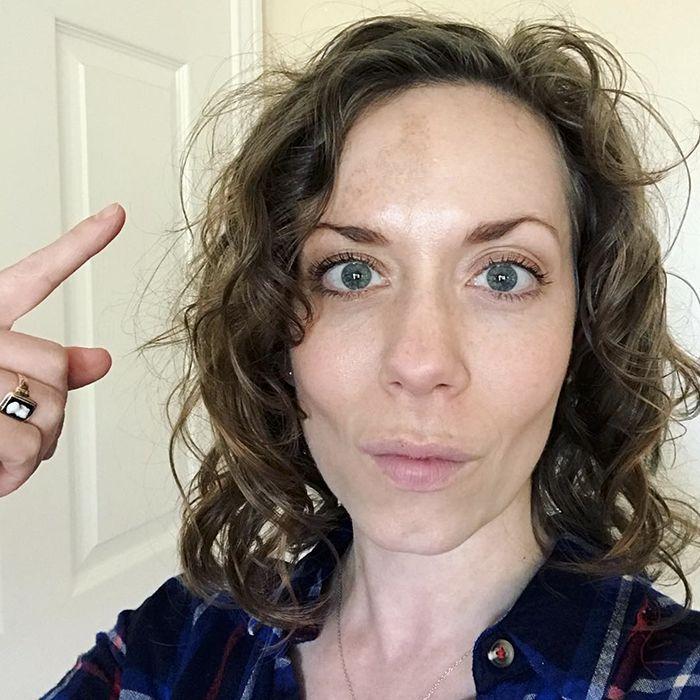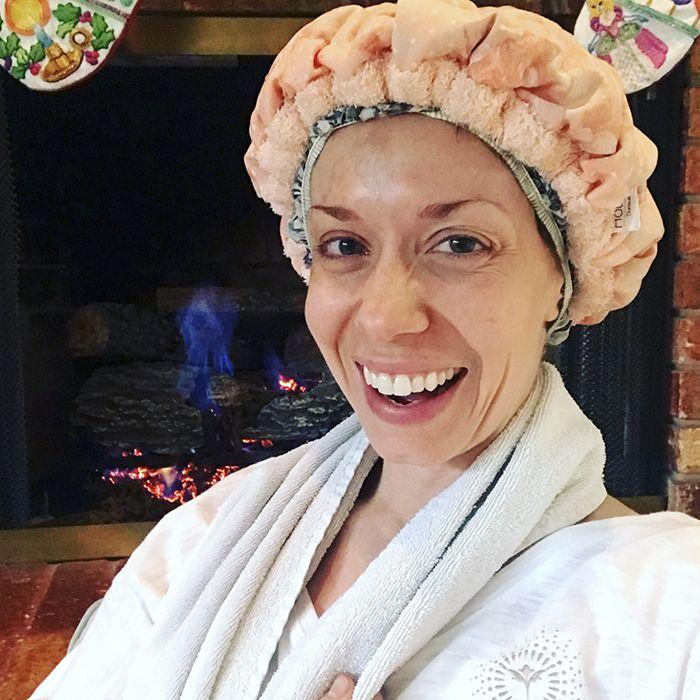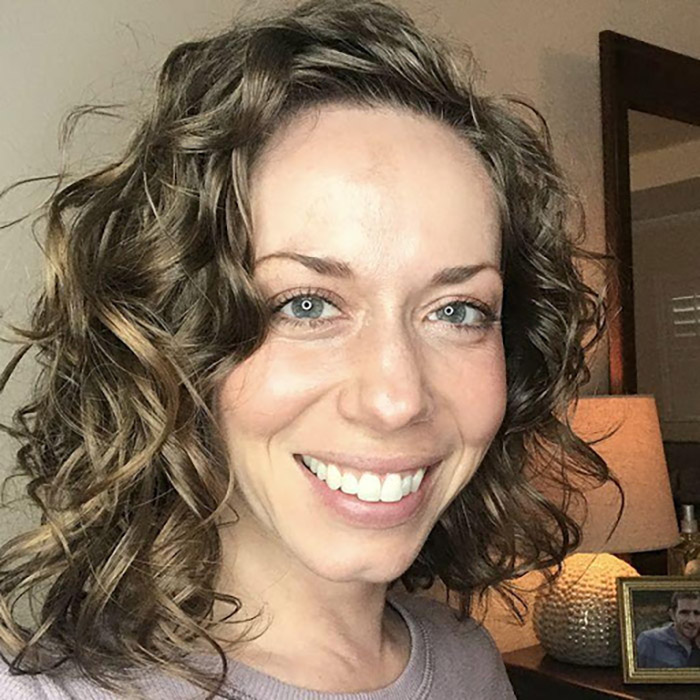It’s true: Wavy hair isn’t the same as curly hair. Of course, we wavies do still want to give our hair the TLC it deserves (so keep visiting this website for all kinds of great info about your gorgeous waves”>! But because of the nature of our loose curls, a.k.a. waves, we have a separate set of needs from our curly sisters.
I personally believe the reason behind these differences mostly has to do with how easily the natural oil from our scalp is able to travel the lengths of our strands. For wavies, having fewer loops in the way makes it much easier for that oil, also known as sebum, to naturally moisturize our hair from root to tip. So when we read a fantastic book like Curly Girl: The Handbook, Expanded 2nd edition, written by Lorraine Massey who has type 3 curls. In the Curly Girl Method that she outlines in her book, she tells us that we don’t need shampoo. So, we think maybe we should give up shampoo altogether. But what if that’s a mistake for us wavy girls?
What other mistakes could we be making we haven’t even considered?
If your hair is acting ‘off’, or you’re consistently unhappy with your wavy locks, maybe you, too, have been making one (or more”> of these mistakes I often see my wavy friends making.
The Mistake: Exclusively Co-Washing
Unless your hair and scalp are exceedingly dry, in my experience, wavies really benefit much more from a consistent cycle of cowashing and using a sulfate-free shampoo (otherwise known as a low-poo”>.
The Solution:
Cowash some of the time. It’s a great way to preserve moisture, but you may experience buildup over time as your sebum plus the ingredients of your cowash add up. I personally benefit the most from a consistent washday rotation/schedule of:
- cowash
- cowash
- low-poo
- cowash
- cowash
- low-poo
And I usually wash every 2-3 days.
The only thing that interrupts my washday rotation is the need to clarify (we’ll talk about this next”>, as there are some Curly Girl (CG”>-friendly ingredients that even a low-poo can’t easily remove (e.g., behentrimonium methosulfate, polyquaterniums, castor oil, etc.”>.
My favorite cowash:
It continues to be the As I Am Coconut Cowash, as I find it to be more cleansing than using a thin conditioner, but less stripping than a sulfate free shampoo. It contains cetrimonium chloride, a gentle cleansing agent. It also contains castor oil which is very moisturizing but can build up on the hair, so this product should be used in tandem with regular clarifying.

THIS IS BUILDUP FRIZZ IN MY HAIR FROM NOT CLARIFYING.
2. The Mistake: Not Clarifying
This is probably the number one mistake I see wavies new to CG making when they reach out to me via Instagram or Facebook, seeking help. The good news is that it’s a really quick fix! As I mentioned above the buildup is inevitable, even for those following Lorraine Massey’s Curly Girl Method, closely or loosely.
The solution:
Get the gunk off! I keep a reminder on my calendar to clarify every 3 weeks. And should I decide to skip clarifying once or twice on my regular schedule, I’ve almost always made the wrong decision. How do I know? When I’m faced with buildup frizz. Frizz has SO many causes, and buildup is absolutely one of them. I also get immediate buildup frizz when styling with heavy oils and butter-based products… but back to clarifying. Just as important as staying on a regular schedule of clarifying (which should always be followed up by a deep conditioner, but more on that, next”> is also choosing the right clarifying shampoo. For me, a sulfate-free clarifying shampoo isn’t going to cut it. It takes specific surfactants (e.g. sodium laureth sulfate (SLS”> or sodium c14-c16 olefin sulfonate“> to remove certain ingredients that cling tightly to our hair–and those surfactants should be at the top of the ingredients list. If they’re listed near the middle to end of the list on your bottle of shampoo, the likelihood is that it won’t be strong enough to remove those polyquats or conditioning agents. I have some wavy-curly friends that choose to rotate their clarifying sessions between stronger and weaker clarifying shampoos (i.e. Kinky Curly Come Clean”>, but I prefer to play it consistently and use the same one every time.
My favorite clarifiers are:
3. The Mistake: Skipping Deep Conditioning Sessions

While we wavies may not need as frequent or intense deep conditioning as our curly-headed friends, regular deep conditioning will lend our hair greater softness, bounce, manageability, and curl retention.
The solution:
Weekly or bi-weekly treatments are essential for ‘feeding’ our waves. If you are new to the Curly Girl Method and you have a lot of damage, you probably need to deep condition every week, but you will need to find what works best for you. The most important components of deep conditioning are TIME and QUALITY. And it doesn’t have to be expensive! In lieu of a labeled ‘deep conditioner’, just combine a scoop of your favorite conditioner with 1 tbsp each of honey and your favorite oil (olive oil is my favorite”> to make any conditioner more intense. Slather it on freshly washed, wet hair, leave it for 30 minutes, then rinse completely before styling as usual. Says Wendy, scientist and author behind The Science-y Hairblog, in a two-part post on deep conditioning: “When lipids (oily ingredients”> are present in a conditioner formula (or when you add them”>, you get even more conditioning goodness adhering to your hair–more cationic conditioning and more softness and flexibility from the lipid…for an even better end result.” In part 2, she adds: “Leaving a cationic conditioning ingredient or protein treatment on longer can lead to greater adherence (adsorption”> of conditioning ingredients on your hair. 30 minutes of deep conditioning can give you twice as much conditioning for your hair ingredients as 5 minutes can.” I totally skimped on the time aspect for months. Because who wants to get wet again after being out of the shower for 30 minutes?? My hack: Once I got my hands on a handheld showerhead, deep conditioning became less of a chore. I was able to apply my deep conditioner in the shower, put on my shower cap, dry off and get dressed. Once my 30 minutes was up, I just leaned my head back into the shower, and used my handheld showerhead to rinse it all out, then styled as usual.
My favorite deep conditioners are: Curl Junkie Curl Rehab and Jessicurl Deep Treatment. Unlike other conditioners I’ve tried, they don’t lead to build-up frizz. And I adore my Hot Head by Thermal Haircare to increase treatment intensity. It has cut my conditioning time in half.
4. The Mistake: Raking in Your Styling Products
Wavy hair, in my experience, just doesn’t naturally clump the same way curly hair does. I’m not saying curly girls have it easy! But if a Denman brush could whip my wavy clumps into shape like it does for my curly friends, I’d feel like I won the lottery. Instead, it leaves me with stringy, 80’s perm-looking hair.
The solution:
Waves require different techniques. First, I start with the super soaker method then squish to condish to lay a great foundation for juicy curl clumps. Lots of water is key. For product application, my go-to is smooth and scrunch. I emulsify every product between my hands, smooth it over in just a few sections, and then squish/scrunch on dripping-wet hair until I can no longer feel the product in my hair. Praying hands is another excellent technique to ensure your ends are covered with product without raking it through, but I’m always carefully to not stretch my waves too much, as my goal is enhancement rather than elongation.
My favorite way to apply products:
- In spring and summer, I follow the LCEG product layering method: leave-in, cream, enhancing gel, hard-hold gel. Wavy hair can tolerate heavier products during the more humid months of the year.
- In fall and winter, when the air is the driest, I follow the LEG method: leave-in, enhancing gel, hard-hold gel.
Note that wavies living in dry climates may want to switch this routine so that LEG is used in the drier months, like July-September, and LCEG is used in t
he rainy season (late Winter/Early Spring”>.

5. The Mistake: Expecting Hold from The Wrong Products
You’ve just styled your hair. All the products, the squish to condish, the plopping, clipping roots, maybe diffusing… If you’re doing all that, the last thing you want to see is your type 2 waves drooping by day’s end. So why are you relying on a cream to hold your style?
The solution:
Use gel. I remember almost laughing when I read that in The Curly Girl Method handbook. Gel? That blue L.A. Looks stuff my brother used in high school?? On my wet hair??? Turns out, she was right. Using products that lend the right amount of hold for both your individual hair’s needs and the ‘look’ you prefer (hard vs. medium vs. light hold”> will make all the difference in how your style holds up throughout the day, and can even catapult your washday hair into multiple days. That said, not all gels are created equal, so you’ll need to do a fair amount of experimenting to find one that lends hold without weighing down your wavy locks. But–knowing what I know now, I would never cap my wash day product lineup with a leave-in, cream or custard if my goal was the see my waves hold up for a full day or more. That’s the job of a gel, and–in my mind–nothing can replace it. I’m a total gel connoisseur.
My all-time favorite gels include:
- Ouidad Advanced Climate Control
- Kenra 17
- Bounce Curl
- Innersense I Create Hold
- Jessicurl Spiralicious
- Raw Curls firm hold
- Boucleme
- Zerran firm hold
- Biosilk Rock Hard Gelee
- And, ironically enough, L.A. Looks Sport gel–yes, the blue one
6. The Mistake: Not Getting Regular Trims
Just like any other hair type, wavies experience dry, split ends which can drag down hair, make it look dull and frizzy, and make conditioning and styling a chore.
The Solution: Schedule a Trip to the Salon
Whether it’s every quarter or on an as-needed basis, get rid of those dead ends if you want your hair to be healthy and manageable. While you can splurge on a fancy curl by curl cut, you might find that you do just fine with a normal trim on wet hair.
7. The Mistake: Not Choosing the Right Products for Your Hair
Everyone’s hair is unique. Even though certain products might be perfect for your wavie sisters, you might find they don’t work as well for you. There are a myriad of reasons for this, including your hair’s porosity and density, the climate in which you live, your allergies and sensitivities, and even your technique.
The Solution: Use the tips and tools on this website as your guide.
These are tools that can make your life so much easier, and help you to transition with ease. They include:
Texture Quiz to help you identify your hair’s texture, density, porosity and other variables so that you can more easily find products, styles, and advice.
Frizz Forecast for planning you perfect hair days no matter what the weather.
Customizable searches on our site and in our shop to allow you to find what you need quickly.
8. The Mistake: Becoming Overwhelmed by the Curly Girl Method
If you wander onto any Facebook Curly Girl Method Support Group, or onto a curly-themed Reddit forum, you will inevitably find newbies of every hair type asking “where do I start”? There is so much information on the internet, with seemingly complicated lists of dos, don’ts, shouldn’ts, and maybes, that it can be overwhelming. What at first glance appears to be information overload is really just extra details and tips that you don’t need when you are first transitioning. In time, though, they CAN help you troubleshoot and adjust your regimen so that it perfectly meets your hair’s needs.
The Solution: Fully familiarize yourself with the Curly Girl Method before embarking on any adaptations of it.
First, pick up a copy of Curly Girl: The Handbook, Expanded 2nd edition, and read through it. Many wavies and curlies skip this step. Now, as a wavy, there will be certain things that won’t work for you (for example, the number 1 mistake on this list”>, but it is important to start with a good foundation of knowledge. This book outlines a simple and specific process for hair care which includes the following:
- Make sure to do a “final wash”. Before you can embark on this method, you will need to wash your hair with a shampoo containing sodium lauryl sulfate in order to remove any silicones, parabens, and product build-up.
- Moving forward, select hair care products that are free of silicones that are not water-soluble, parabens, and drying alcohols, and possibly sulfates (see #3 on this list for more on this”>.
- Originally, Lorraine Massey recommended completely ditching shampoo and co-washing, or washing with conditioner only. This method didn’t work for everyone, and that is reflected in the Devacurl product line which now includes sulfate-free, low-lather gentle shampoos (or low-poos“>, and a micellar water based Build-up Buster. As a wavy, you may find that you prefer to use sulfates as Alyson does.
- When washing, co-washing and/or conditioning your hair, use your fingers to detangle instead of combs and brushes. You will find that this approach causes less breakage.
- On fully saturated hair, apply your choice of leave-in, creams, or other stylers (for example, those you would use in the LCEG or the LEG methods”> while your hair is soaking wet. Applying your products in the shower is one way to ensure that you get good product distribution.
- Scrunch your hair. Using clips, clip you roots for maximum volume, or you can scrunch out excess water using a microfiber towel, tee-shirt, or paper towel.
- Air dry or diffuse your waves on a cool setting—no heat!
- When your hair is fully dry, a gel cast will have formed. Scrunch out this cast for frizz-free defined waves.
What mistakes did you make when you first embarked on your journey? Sharing is caring!
Join in the discussion on Facebook!
Note: This article was published on 2/6/19 and has been updated with three more reader tips to help you rock your waves.
